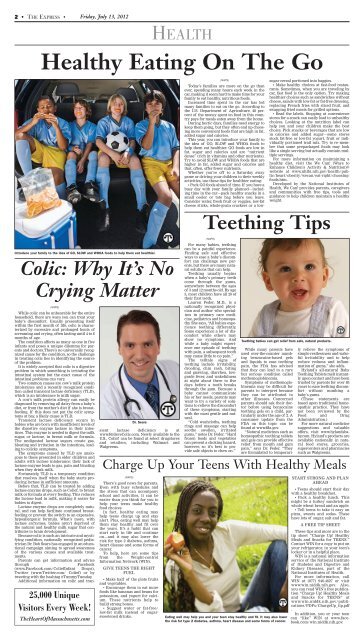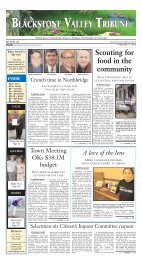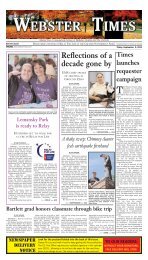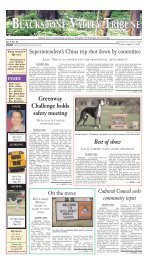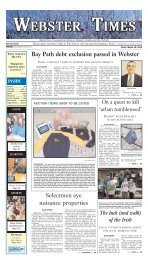friday july 13 - Southbridge Evening News
friday july 13 - Southbridge Evening News
friday july 13 - Southbridge Evening News
Create successful ePaper yourself
Turn your PDF publications into a flip-book with our unique Google optimized e-Paper software.
2 • THE EXPRESS • Friday, July <strong>13</strong>, 2012<br />
HEALTH<br />
Healthy Eating On The Go<br />
(NAPS)<br />
Today’s families are more on the go than<br />
ever, spending many hours each week in the<br />
car, making it seem hard to make time for your<br />
family to eat healthy, nutritious foods.<br />
Increased time spent in the car has led<br />
many families to eat on the go. According to<br />
the U.S. Department of Agriculture, 48 percent<br />
of the money spent on food in this country<br />
pays for meals eaten away from the home.<br />
During hectic days, families need energy to<br />
keep them going, but they often end up choosing<br />
more convenient foods that are high in fat,<br />
added sugar and calories.<br />
This year, you can introduce your family to<br />
the idea of GO, SLOW and WHOA foods to<br />
help them eat healthier. GO foods are low in<br />
fat, sugar and calories and are “nutrient<br />
dense” (rich in vitamins and other nutrients).<br />
Try to avoid SLOW and WHOA foods that are<br />
higher in fat, added sugar and calories and<br />
that, often, offer fewer nutrients.<br />
Whether you’re off to a Saturday away<br />
game or driving your children to their weekly<br />
activities, use these tips for healthier eating:<br />
• Pack GO foods ahead of time. If you have a<br />
busy day with your family planned—including<br />
time in the car—pack healthy snacks in a<br />
small cooler or tote bag before you leave.<br />
Consider water, fresh fruit or veggies, low-fat<br />
cheese sticks, whole-grain crackers or a lowsugar<br />
cereal portioned into baggies.<br />
• Make healthy choices at fast-food restaurants.<br />
Sometimes, when you are traveling by<br />
car, fast food is the only option. Try making<br />
healthier choices such as sandwiches without<br />
cheese, salads with low-fat or fat-free dressing,<br />
replacing French fries with sliced fruit, and<br />
swapping fried meats for grilled options.<br />
• Read the labels. Stopping at convenience<br />
stores for a snack can easily lead to unhealthy<br />
choices. Looking at the nutrition label can<br />
help you and your children make the best<br />
choice. Pick snacks or beverages that are low<br />
in calories and added sugar—some stores<br />
stock fat-free or low-fat yogurt, fruit or individually<br />
portioned trail mix. Try to re–member<br />
that some prepackaged foods may look<br />
like a single serving but actually contain multiple<br />
servings.<br />
For more information on maintaining a<br />
healthy diet, visit the We Can! (Ways to<br />
Enhance Children’s Activity & Nutrition)®<br />
website at www.nhlbi.nih.gov/health/public/heart/obesity/wecan/eat-right/choosingfoods.htm.<br />
Developed by the National Institutes of<br />
Health, We Can! provides parents, caregivers<br />
and communities with free tips, tools and<br />
guidance to help children maintain a healthy<br />
weight.<br />
Introduce your family to the idea of GO, SLOW and WHOA foods to help them eat healthier.<br />
Colic: Why It’s No<br />
Crying Matter<br />
(NAPS)<br />
25,000 Unique<br />
Visitors Every Week!<br />
TheHeartOfMassachusetts.com<br />
While colic can be unbearable for the entire<br />
household, there are ways you can treat your<br />
baby’s discomfort. Usually presenting itself<br />
within the first month of life, colic is characterized<br />
by excessive and prolonged bouts of<br />
screaming and crying, often lasting until 4 to 6<br />
months of age.<br />
The condition affects as many as one in five<br />
infants and poses a unique dilemma for parents<br />
and doctors.There’s no universally recognized<br />
cause for the condition, so the challenge<br />
in treating colic lies in identifying the source<br />
of the problem.<br />
It is widely accepted that colic is a digestive<br />
problem in which something is irritating the<br />
intestinal system but the exact cause of the<br />
intestinal problems can vary.<br />
Two common causes are cow’s milk protein<br />
intolerance and a recently recognized condition<br />
called transient lactase deficiency (TLD),<br />
which is an intolerance to milk sugar.<br />
A cow’s milk protein allergy can easily be<br />
diagnosed by removing all dairy from a baby’s<br />
diet, or from the mother’s diet if she is breastfeeding.<br />
If this does not put the colic symptoms<br />
at bay, a likely cause is TLD.<br />
Transient lactase deficiency occurs in<br />
babies who are born with insufficient levels of<br />
the digestive enzyme lactase in their intestines.<br />
This enzyme is needed to digest the milk<br />
sugar, or lactose, in breast milk or formula.<br />
The undigested lactose sugars create gas,<br />
bloating and irritation in the intestines, leading<br />
to colicky symptoms.<br />
The symptoms caused by TLD are analogous<br />
to those presented in older children and<br />
adults with lactose intolerance; their lack of<br />
lactase enzyme leads to gas, pain and bloating<br />
when they drink milk.<br />
Fortunately, TLD is a temporary condition<br />
that resolves itself when the baby starts producing<br />
lactase in sufficient amounts.<br />
Before that, TLD can be treated by adding<br />
lactase enzyme drops, such as Colief, to breast<br />
milk or formula at every feeding. This reduces<br />
the lactose load in milk, making it easier for<br />
babies to digest.<br />
Lactase enzyme drops are completely natural,<br />
and can help facilitate continued breastfeeding<br />
or prevent the switch to an expensive,<br />
hypoallergenic formula. What’s more, with<br />
lactase en?zymes, babies aren’t deprived of<br />
the natural and healthy milk sugar that contributes<br />
to brain development.<br />
Because colic is such an intricate and mystifying<br />
condition, nationally recognized pediatrician<br />
Dr. Bob Sears has engaged in an educational<br />
campaign aiming to spread awareness<br />
of the various causes and available treatments.<br />
Parents can get information and advice<br />
through<br />
Facebook<br />
(www.Facebook.com/ColiefInfant Drops),<br />
Twitter (www.Twitter.com/ Colief) or by<br />
tweeting with the hashtag #TummyTuesday.<br />
Additional information on colic and transient<br />
lactase deficiency is at<br />
www.RelieveColic.com. Newly available to the<br />
U.S., Colief can be found at select drugstores<br />
and retailers, including Walmart and<br />
Walgreens.<br />
Teething Tips<br />
(NAPS)<br />
For many babies, teething<br />
can be a painful experience.<br />
Finding safe and effective<br />
ways to ease a baby’s discomfort<br />
can challenge new parents,<br />
but there are many natural<br />
solutions that can help.<br />
Teething usually begins<br />
when a baby’s primary teeth<br />
come through the gums,<br />
somewhere between the ages<br />
of 3 and 12 months old. By age<br />
3, most children have all 20 of<br />
their first teeth.<br />
Lauren Feder, M.D., is a<br />
nationally recognized physician<br />
and author who specializes<br />
in primary care medicine,<br />
pediatrics and homeopathy.<br />
She says, “All babies experience<br />
teething differently.<br />
Some experience a lot of discomfort<br />
while others may<br />
show no symptoms. And<br />
while a baby might experience<br />
one episode of teething<br />
with pain, a subsequent tooth<br />
may cause little to no pain.”<br />
The telltale signs of<br />
teething include irritability,<br />
drooling, chin rash, biting<br />
and gnawing, diarrhea, lowgrade<br />
fever, and wakefulness<br />
at night about three to five<br />
days before a tooth breaks<br />
through the gum. Because a<br />
baby cannot communicate<br />
his or her needs, parents may<br />
want to try a variety of solutions<br />
to relieve the discomfort<br />
of these symptoms, starting<br />
with the most gentle and natural.<br />
“Cold washcloths, teething<br />
rings and massage can help<br />
soothe swollen, irritated<br />
gums,” notes Dr. Feder. “Hard<br />
frozen foods and vegetables<br />
can present a choking hazard,<br />
however, so it’s best to provide<br />
safe objects to chew on.”<br />
While many parents have<br />
used over-the-counter numbing<br />
benzocaine-based gels<br />
and liquids to ease teething<br />
pain, the FDA has advised<br />
that they can lead to a rare<br />
but serious condition called<br />
methemoglobinemia.<br />
Symptoms of methemoglobinemia<br />
may be difficult for<br />
parents to interpret because<br />
they can be attributed to<br />
other illnesses. Concerned<br />
parents should ask their doctor<br />
before using benzocaine<br />
teething gels on a child, particularly<br />
under the age of 2. A<br />
consumer update from the<br />
FDA on this topic can be<br />
found at www.fda.gov.<br />
“Natural medicines such as<br />
homeopathic teething tablets<br />
and gels can provide effective<br />
relief from mouth and gum<br />
pain,” says Dr. Feder. “They<br />
are formulated to temporarily<br />
relieve the symptoms of<br />
simple restlessness and wakeful<br />
irritability and to help<br />
reduce redness and inflammation<br />
of gums,” she adds.<br />
Hyland’s all-natural Baby<br />
Teething Tablets melt instantly<br />
upon contact and have been<br />
trusted by parents for over 85<br />
years to ease teething discomfort<br />
without numbing a<br />
baby’s gums.<br />
(These statements are<br />
based upon traditional homeopathic<br />
practice. They have<br />
not been reviewed by the<br />
Food and Drug<br />
Administration.)<br />
For more natural medicine<br />
suggestions and valuable<br />
offers, visit www.hylandsbaby.com.<br />
Hyland’s products are<br />
available nationally in natural<br />
food stores, groceries,<br />
supercenters and pharmacies<br />
such as Walgreens.<br />
Charge Up Your Teens With Healthy Meals<br />
(NAPS)<br />
Dr. Sears<br />
There’s good news for parents.<br />
Even with busy schedules and<br />
the stress that can accompany<br />
school and activities, it can be<br />
easier than you think for you to<br />
help your teens make healthy<br />
food choices.<br />
In fact, healthy eating may<br />
help teens charge up and stay<br />
alert. Plus, eating well may help<br />
them stay healthy and fit over<br />
the years. It’s a habit that can<br />
start early in life and continue<br />
on—and it may also lower the<br />
risk for type 2 diabetes, asthma,<br />
heart disease and some forms of<br />
cancer.<br />
To help, here are some tips<br />
from the Weight-control<br />
Information Network (WIN).<br />
GIVE TEENS THE RIGHT<br />
FUEL<br />
• Make half of the plate fruits<br />
and vegetables.<br />
• Encourage them to eat more<br />
foods like bananas and beans for<br />
potassium, and yogurt for calcium.<br />
These nutrients help to<br />
build strong bones.<br />
• Suggest water or fat-free/<br />
low-fat milk instead of sugarsweetened<br />
drinks.<br />
Teething babies can get relief from safe, natural products.<br />
Eating well may help you and your teen stay healthy and fit. It may also lower<br />
the risk for type 2 diabetes, asthma, heart disease and some forms of cancer.<br />
START STRONG AND PLAN<br />
AHEAD<br />
• Teens should start their day<br />
with a healthy breakfast.<br />
• Pack a healthy lunch. This<br />
might be a turkey sandwich on<br />
whole wheat bread and an apple.<br />
• Tell teens to take it easy on<br />
pizza, sweets and sodas. These<br />
have lots of sugar, salt and fat.<br />
A FREE TIP SHEET<br />
These tips and more are in the<br />
tip sheet “Charge Up! Healthy<br />
Meals and Snacks for TEENS.”<br />
Contact WIN for a copy to put on<br />
your refrigerator, in your teen’s<br />
locker or in a helpful place.<br />
WIN is a national information<br />
service of the National Institute<br />
of Diabetes and Digestive and<br />
Kidney Diseases, part of the<br />
National Institutes of Health.<br />
For more information, call<br />
WIN at (877) 946-4627 or visit<br />
www.win.niddk.nih.gov. Also,<br />
you can read WIN’s free publication<br />
“Charge Up! Healthy Meals<br />
and Snacks for TEENS” at<br />
www.win.niddk.nih.gov/publications/PDFs/ChargeUp_tip.pdf<br />
.<br />
In addition, you or your teen<br />
can “like” WIN at www.facebook.com/win.niddk.nih.gov.


